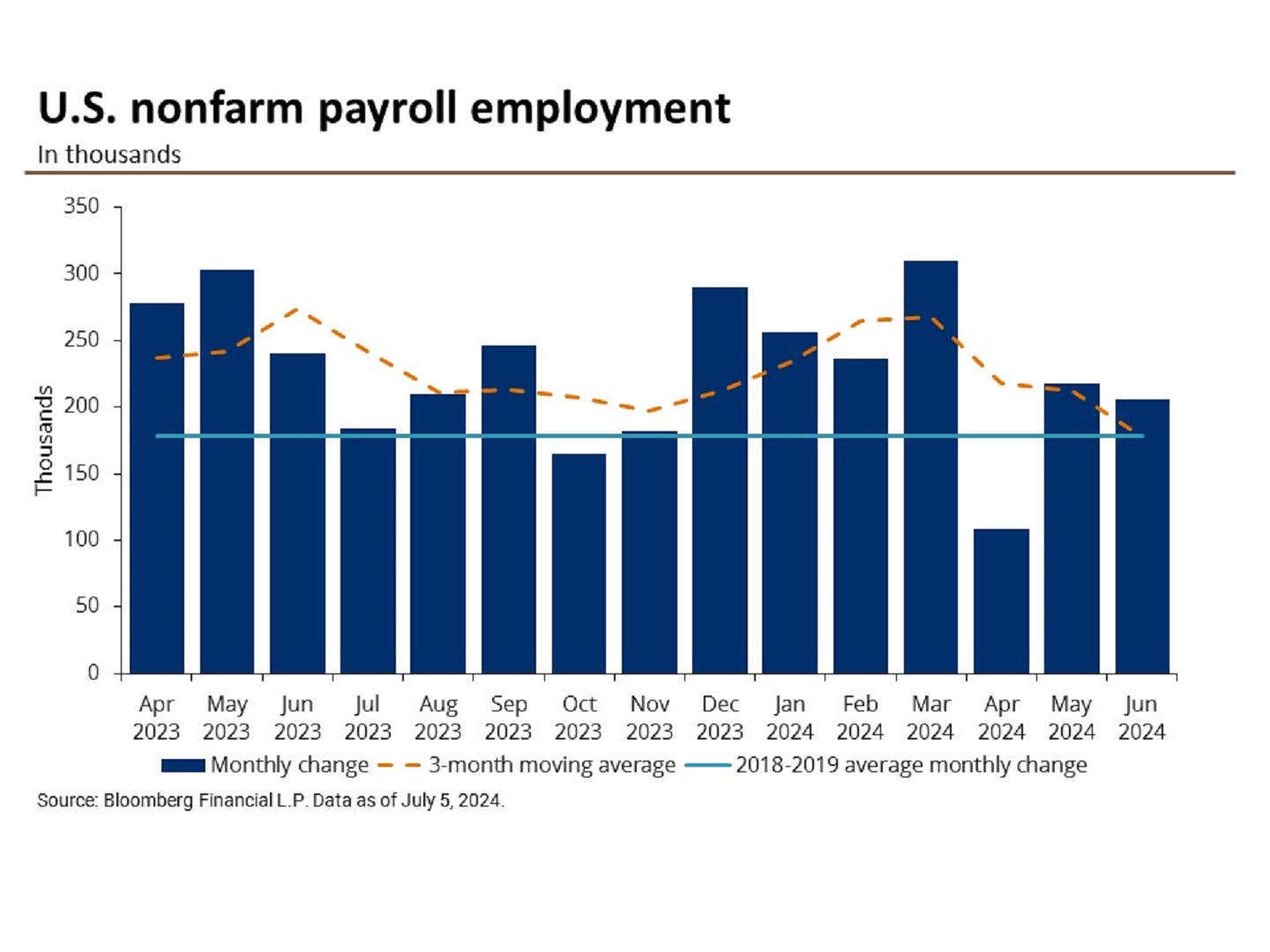
Key takeaways
- The Bureau of Labor Statistics (BLS) reported that the U.S. economy added 206,000 jobs in June 2024, a report in line with consensus expectations. However, there were 111,000 of downward revisions for April and May. That took the 3-month average of payroll gains down to 177,000, the slowest pace since January of 2021.
- Job growth was narrowly based for June, with government and healthcare jobs accounting for nearly three-fourths of total job gains.
- The unemployment rate ticked up to 4.1%, its highest level since 2020 and has increased in each of the last three months.
- Meanwhile, average hourly earnings were up 0.3% month-over-month (MoM) and 3.9% year-over-year (YoY) in June, the slowest pace since 2021.
- The June jobs report underscores a steady jobs market with wage gains for the U.S. consumer. This jobs report is a step in the right direction in the eyes of the Federal Reserve, however they will look for additional data that the economy is moderating before considering rate cuts later this year.
Contributors

Editorial staff, J.P. Morgan Wealth Management
A softer labor market
The June jobs report highlights a steady labor market that is ever so slightly loosening. The U.S. labor market added 206,000 jobs in June, in line with expectations. May’s nonfarm payroll gains were revised down 54,000 to 218,000, while April’s nonfarm payroll gains were revised down by another 57,0000 to 108,000.1
June’s nonfarm payroll gains bring the three-month average employment gain to 177,000 jobs, the slowest pace since January 2021. This highlights that restrictive Federal Reserve policy is cooling the pace of job growth.

Industry breakdown
Job growth was narrowly based in June, with government and healthcare jobs accounting for nearly three-fourths of total job gains. The strong increase in government jobs (+70,000) was driven by job gains at the state and local level (+65,000).
Private sector payrolls continued to slow in June to 136,000 from 193,000 in May, with healthcare and social assistance accounting for 82,000 of those jobs.2 Diving deeper into the details, goods producing jobs rose 19,000 in June, as strong gains in construction employment offset a decline in manufacturing jobs. There was some June weakness in the service sector, as employment increased 117,000, down from 181,000 in May. While the healthcare sector saw strong gains in June, most other service sectors lost momentum.
Employment was weak in the professional and business services, contracting by 17,000 due to a large decline in temporary help.3 Employment in the leisure and hospitality sector was quite weak in June, contributing only 7,000 jobs.
Unemployment rates and growth
The labor market remains steady, despite showing some signs of moderating. A portion of the data shows that we’re starting to see the job market come into equilibrium, which should slow the pace of job growth. The overall unemployment rate ticked up to 4.1% in June, its highest level since 2020 and has increased in each of the last three months. This uptick was driven by a rise in the unemployment rate for prime age workers, which account for two thirds of the labor force. There was also a welcome increase in the labor force participation rate to 62.6%, driven by a rise in labor force participation of prime age workers to 83.7%, the highest since February 2022.4
The reading for the June average hourly earnings data, an important measure for inflation, rose 0.3% MoM. Year-over-year (YoY), average hourly earnings have slowed to 3.9% in June, down from 4.1% in May. Most other measures of wage growth are moving in the right direction in the eyes of the Fed; even forward looking measures of wages point to further slowing of wage gains.5
The number of job openings in May unexpectedly rose to 8.14 million from a downward-revised 7.92 million in April according to the BLS Job Openings and Labor Turnover Summary report released this week.6 This release disrupted what has been, and is likely to continue to be, a gradual further cooling trend in labor demand.

Rate implications
The June jobs report underscores a steady jobs market with wage gains for the U.S. consumer. This jobs report is a step in the right direction in the eyes of the Fed, however they will look for additional data that the economy is moderating before considering rate cuts later this year.
At June’s Federal Open Market Committee (FOMC) meeting, they unanimously voted to hold policy rates steady for the seventh consecutive time, leaving the Fed Funds Target Rate unchanged at 5.25% to 5.50%.7
The Fed said it needs to see more compelling and broader evidence that inflation is moving closer to its 2% target before considering rate cuts later this year. The Consumer Price Index (CPI) rose 3.3% in May, a decline from the 3.4% YoY rise in April.8
Chair Powell underscored that the Fed’s decision on the direction of rates continues to be "meeting by meeting" with the "data leading the way," but noted “modest further” inflation progress.9
The June inflation report is set to be released on July 11 and will play a role in the Fed’s interest rate decision-making process at its next FOMC meeting. However, it’s important to note the Fed’s preferred measure of inflation, the Personal Consumption Expenditures (PCE) deflator, will be released July 26 and will likely play a larger role in what they decide moving forward. While we believe the Fed will begin cutting rates at the end of the year, that timeline could be pulled forward if both inflation and employment further cool in the months ahead.
References
Bureau of Labor Statistics. “The Employment Situation—June 2024.”
Ibid.
Ibid.
Ibid.
Ibid.
Bureau of Labor Statistics, “May Job Openings and Labor Turnover Summary.” (June 2024)
Federal Reserve. “Federal Reserve issues FOMC statement.”
Bureau of Labor Statistics. “Consumer Price Index – May 2024.”
Board of Governors of the Federal Reserve System. “Speech – Opening Remarks.”
Connect with a Wealth Advisor
Our Wealth Advisors begin by getting to know you personally. To get started, tell us about your needs and we’ll reach out to you.
IMPORTANT INFORMATION
This material is for informational purposes only, and may inform you of certain products and services offered by J.P. Morgan’s wealth management businesses, part of JPMorgan Chase & Co. (“JPM”). Products and services described, as well as associated fees, charges and interest rates, are subject to change in accordance with the applicable account agreements and may differ among geographic locations. Not all products and services are offered at all locations. If you are a person with a disability and need additional support accessing this material, please contact your J.P. Morgan team or email us at accessibility.support@jpmorgan.com for assistance. Please read all Important Information.
GENERAL RISKS & CONSIDERATIONS. Any views, strategies or products discussed in this material may not be appropriate for all individuals and are subject to risks. Investors may get back less than they invested, and past performance is not a reliable indicator of future results. Asset allocation/diversification does not guarantee a profit or protect against loss. Nothing in this material should be relied upon in isolation for the purpose of making an investment decision. You are urged to consider carefully whether the services, products, asset classes (e.g. equities, fixed income, alternative investments, commodities, etc.) or strategies discussed are suitable to your needs. You must also consider the objectives, risks, charges, and expenses associated with an investment service, product or strategy prior to making an investment decision. For this and more complete information, including discussion of your goals/situation, contact your J.P. Morgan representative.
NON-RELIANCE. Certain information contained in this material is believed to be reliable; however, JPM does not represent or warrant its accuracy, reliability or completeness, or accept any liability for any loss or damage (whether direct or indirect) arising out of the use of all or any part of this material. No representation or warranty should be made with regard to any computations, graphs, tables, diagrams or commentary in this material, which are provided for illustration/reference purposes only. The views, opinions, estimates and strategies expressed in this material constitute our judgment based on current market conditions and are subject to change without notice. JPM assumes no duty to update any information in this material in the event that such information changes. Views, opinions, estimates and strategies expressed herein may differ from those expressed by other areas of JPM, views expressed for other purposes or in other contexts, and this material should not be regarded as a research report. Any projected results and risks are based solely on hypothetical examples cited, and actual results and risks will vary depending on specific circumstances. Forward-looking statements should not be considered as guarantees or predictions of future events.
Nothing in this document shall be construed as giving rise to any duty of care owed to, or advisory relationship with, you or any third party. Nothing in this document shall be regarded as an offer, solicitation, recommendation or advice (whether financial, accounting, legal, tax or other) given by J.P. Morgan and/or its officers or employees, irrespective of whether or not such communication was given at your request. J.P. Morgan and its affiliates and employees do not provide tax, legal or accounting advice. You should consult your own tax, legal and accounting advisors before engaging in any financial transactions.
Legal Entity and Regulatory Information.
J.P. Morgan Wealth Management is a business of JPMorgan Chase & Co., which offers investment products and services through J.P. Morgan Securities LLC (JPMS), a registered broker-dealer and investment adviser, member FINRA and SIPC. Insurance products are made available through Chase Insurance Agency, Inc. (CIA), a licensed insurance agency, doing business as Chase Insurance Agency Services, Inc. in Florida. Certain custody and other services are provided by JPMorgan Chase Bank, N.A. (JPMCB). JPMS, CIA and JPMCB are affiliated companies under the common control of JPMorgan Chase & Co. Products not available in all states.
Bank deposit accounts and related services, such as checking, savings and bank lending, are offered by JPMorgan Chase Bank, N.A. Member FDIC.
This document may provide information about the brokerage and investment advisory services provided by J.P. Morgan Securities LLC (“JPMS”). The agreements entered into with JPMS, and corresponding disclosures provided with respect to the different products and services provided by JPMS (including our Form ADV disclosure brochure, if and when applicable), contain important information about the capacity in which we will be acting. You should read them all carefully. We encourage clients to speak to their JPMS representative regarding the nature of the products and services and to ask any questions they may have about the difference between brokerage and investment advisory services, including the obligation to disclose conflicts of interests and to act in the best interests of our clients.
J.P. Morgan may hold a position for itself or our other clients which may not be consistent with the information, opinions, estimates, investment strategies or views expressed in this document. JPMorgan Chase & Co. or its affiliates may hold a position or act as market maker in the financial instruments of any issuer discussed herein or act as an underwriter, placement agent, advisor or lender to such issuer.








